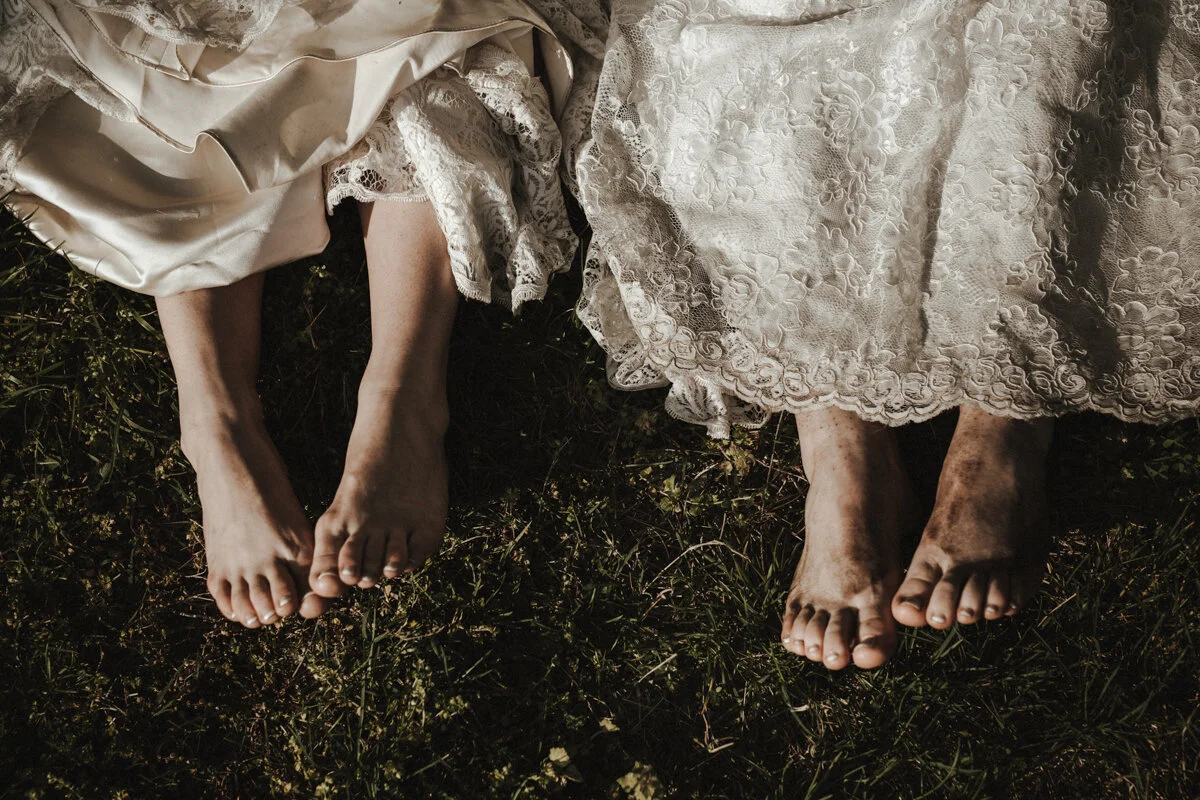Five Reasons to Be Inspired by Quaker Weddings
/Photos by Emily Wren Photography
My husband and I allowed no photography during our wedding ceremony, which was not an easy decision to make.
On the one hand, we knew we wanted to have a photographer document all of the significant moments of the day. But on the other hand, we wanted the ceremony to be intimate and sacred.
We were having a Quaker wedding ceremony, and in Quaker weddings, the couple and all those present worship in silence together. When the couple is ready to exchange vows, they stand and do so. Typically, this is followed by a period of silence where anyone present can then stand and share a message inspired by the couple and the occasion.
We decided that the sound of the camera, the motion of the photographer, and the sheer act of documenting a religious ceremony, in which people are asked to be fully present, were good reasons to omit it. We added “no photography” to our wedding website, and my parents included the reminder in their welcoming notes to our guests.
I remember our wedding ceremony so completely — the light breezy air coming through the wide open windows of the Quaker meeting house, the bright sky showing through a skylight over our heads, and the smiles of loved ones all around us. I remember the absolute joy and the palpable energy that my husband and I shared as we sat together in what will surely be counted as one of the best moments of our lives.
Sitting on benches surrounded by our friends and family, my fiancé and I spent ten or so minutes collecting ourselves in the jubilant silence and energy of the room. Then together, out of the quiet, we stood and exchanged our vows:
In the presence of God, and these our family and friends, I take thee to be my beloved husband/wife, promising to be a loving and faithful partner so long as we both shall live.
I remember our wedding ceremony so completely — the light breezy air coming through the wide open windows of the Quaker meeting house, the bright sky showing through a skylight over our heads, and the smiles of loved ones all around us.
With the exchange of vows, followed by the exchange of rings, we had married ourselves. The pure joy and magnitude of our union was breathtaking. The moment was a culmination of all of the love and work we had poured into our relationship over the course of several years. Together, with all of our loved ones present, we had joined our lives.
The rest of the ceremony was basically a love bath. Our friends and family showered us with messages full of memories, hope, and support. We laughed and cried and were able to be truly present.
After the ceremony, we had a big un-Quakerly party to celebrate. It was a day that we’ll always remember.
A few weeks after our wedding, our photographer, Emily, sent us our photos. We clicked through them and saw one that immediately took our breath away: she had snuck outside of the ceremony and snapped a photo of us just after we exchanged our vows.
This will forever be my favorite photo.
Below are five ways to find inspiration from Quaker wedding traditions.
1. Choosing a Quaker Wedding
Having grown up as a Quaker, and having seen several Quaker weddings, I had always wanted to get married the Quaker way. Quakers believe that there is “that of God in everyone.” Some Quakers don’t use the word “God”; instead they say the “inner-light.” In any case, for this reason, we worship together in silence without a leader; when one of us is moved to speak, we do. There is no pastor, preacher, rabbi, or imam communicating between the higher power and believers — that’s everyone’s job.
When it comes to marriage, Quakers believe that there is no need for an officiant; a couple can marry themselves. To me, this has always made sense. It allows a couple to take marriage into their own hands and signifies that the marriage is a decision they are making.
2. For Quakers and Non-Quakers: A Special Wedding License
Most people don’t know this, but there is a special kind of marriage license available in Pennsylvania, Wisconsin, Washington, D.C., and Colorado called a self-uniting marriage license. This special license allows a couple to forgo the services of an officiant and marry themselves.
While the license is typically associated with Quakerism, anyone can use the license. The license allows couples to marry on their own terms. I have friends who brought the license skiing in their favorite Colorado mountain town. Between ski runs they whipped out the license, signed it, popped some champagne, and sent their friends and family a selfie.
3. The Quaker Wedding Certificate
Quakers document weddings with a certificate of marriage, which is signed by the couple during the wedding ceremony after vows have been exchanged. The certificate outlines who has been married, when it took place, and what their vows were. The best part of the certificate is that there is room for everyone who witnesses the wedding to sign it.
The couple can get creative with the design of the certificate or keep it simple. Either way, the certificate becomes something that they can keep forever. My husband and I keep our certificate in our living room. It is not only a symbol of our love and commitment to each other, but it also declaratively reminds us of all of the friends and family members who support us.
4. Considering Silence
When planning your wedding ceremony, Quaker or not, consider including silence. Spending time in silence will give you an opportunity to take in the moment and all of its fullness.
5. Allowing Your Friends and Family To Take Part
While not all Quaker weddings are the same, many give guests the opportunity to stand and share a message during the ceremony. A couple’s nearest and dearest can share memories, best wishes, an idea, advice, a song, a poem or story. Not all messages focus exclusively on the couple; some may be about marriage or love more generally.
This article originally appeared in Volume Two of Catalyst Wedding Magazine.
Nikka Landau works for the Paul & Daisy Soros Fellowships for New Americans, a foundation that supports immigrants and the children of immigrants. She lives in New York City.

























